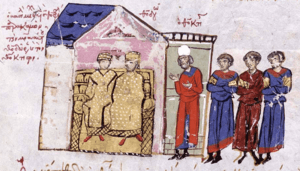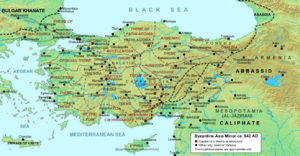Theoktistos facts for kids
Quick facts for kids Theoktistos the Confessor |
|
|---|---|
| Venerated in | Eastern Orthodoxy |
| Feast | 20 November |

Theoktistos (pronounced Thee-ok-TIS-tos) was a very important leader in the Byzantine Empire during the 800s. He was like the main advisor and helper to the young emperor Michael III. From 842 until 855, Theoktistos was basically in charge of the empire.
He was a special court official called a eunuch. He helped Michael II become emperor in 820. Because of this, he was given important titles like patrikios and magistros. He also held high jobs like chartoularios tou kanikleiou (a secretary) and logothetēs tou dromou (like a foreign minister).
After Emperor Theophilos died in 842, Theoktistos became part of a group that ruled for the young emperor Michael III. He quickly became the most powerful person in this group. Theoktistos was known for being very smart and good at managing the empire. He helped end a big religious argument called Byzantine Iconoclasm. He also helped bring back learning and education in the empire.
Theoktistos had some challenges, especially in wars against the Arabs. When Emperor Michael III grew up in 855, his uncle Bardas convinced him to take control. On November 20, 855, Theoktistos was killed by Bardas and his supporters.
Contents
The Early Life of Theoktistos
We don't know much about Theoktistos's early life. He was a eunuch, which means he was a special court official. By 820, he worked for Emperor Leo V the Armenian.
Theoktistos played a big part in a plan to remove Emperor Leo. The new emperor, Michael II the Amorian, rewarded him. He gave Theoktistos the high rank of patrikios. He also made him chartoularios tou kanikleiou, a trusted secretary.
Under Michael's son, Emperor Theophilos, Theoktistos continued to be a key advisor. He became a magistros and was put in charge of foreign affairs as logothetēs tou dromou. Before Emperor Theophilos died in 842, he trusted Theoktistos so much that he made him part of the group that would rule for his two-year-old son, Michael III. This group included the empress-mother Theodora and another important official named Manuel the Armenian.
Leading the Byzantine Empire
After Emperor Theophilos died, the ruling group took over. Empress Theodora's brothers, Bardas and Petronas, and her relative Sergios Niketiates were also important at first.
Ending the Iconoclasm
One of the first things the regency did was to end the Byzantine Iconoclasm. This was a long-standing religious debate that had caused many problems in the empire. It was about whether people should be allowed to use religious images (icons) in worship.
In 843, a meeting of officials and church leaders happened at Theoktistos's house. This meeting became known as the Council of Constantinople. They decided that using icons was good and right. They removed the patriarch (the head of the church) who was against icons. In his place, they chose Methodios I, who had been jailed for supporting icons.
This event is celebrated by the Eastern Orthodox Church every year as the "Triumph of Orthodoxy". Theoktistos was very important in making this happen. Many historical writings say he was the main person who pushed for icons to be brought back. The Orthodox Church remembers him as a saint on November 20.
Wars and Challenges
A week after the icon issue was settled, Theoktistos and Sergios Niketiates led an army to take back Crete. This island had been taken by invaders from Spain in the 820s. The army did well at first, taking most of the island. The invaders were trapped in their main city, Chandax.
However, Theoktistos heard a false rumor that Empress Theodora planned to make her brother Bardas emperor while he was away. He quickly left the army in Crete and rushed back to Constantinople. The rumor was not true.
Soon after, news arrived that Umar al-Aqta, an Arab leader, was invading Asia Minor. Theoktistos led an army to stop him, but the Byzantines lost the Battle of Mauropotamos. At the same time, the army left in Crete was defeated, and Sergios Niketiates was killed.
Even with these military losses, Theoktistos used them to become even more powerful. Bardas was blamed for problems in the battle and sent away from Constantinople. Manuel, another powerful official, was forced to retire. With Niketiates dead, Theoktistos was now the clear leader of the regency.
Theoktistos continued to persecute a religious group called the Paulicians. Many of them fled to Arab lands. There, with help from Umar al-Aqta, they created their own state. Theoktistos made a truce with the Abbasid Caliphate (the Arab empire). They exchanged prisoners in 845. However, in the same year, Byzantine prisoners from an earlier war were executed by the Arabs.
After 845, Arab raids in the east stopped for a few years. But they started again in 851. The Byzantines fought back. In 853, their navy attacked and sacked the port of Damietta in Egypt. The next year, a Byzantine army invaded Arab lands and sacked Anazarbus. About 20,000 prisoners were taken. Some were executed on Theoktistos's orders when they refused to become Christian. This was likely in revenge for the Arabs executing Byzantine prisoners earlier.
To the north, the border with the Bulgars was mostly peaceful. A Bulgar raid was defeated, and a peace treaty was renewed. This peace was later confirmed by the new Bulgar leader, Boris.
However, in the west, the Byzantine government struggled to stop the Muslim conquest of Sicily. Cities like Modica and Leontini fell to the Muslims. A large Byzantine army was defeated in Sicily, losing many soldiers. Over the next few years, Muslims continued to raid Byzantine areas on the island.
Building a Strong Empire
We don't have many details about Theoktistos's policies inside the empire. But he is known for continuing good financial practices. This meant the empire saved a lot of money. By 856, there were huge amounts of gold and silver in the imperial treasury.
He also helped smart people like Constantine-Cyril, who later became a famous saint. Theoktistos made sure Constantine got a good education. He helped him get a job in the church library. Theoktistos also supported other learned people like Leo the Mathematician. His support helped bring back a lot of learning and knowledge in the Byzantine Empire.
Theoktistos also oversaw building projects. He built new structures near the Great Palace of Constantinople. He also put a new iron door in the Chalke Gate. He supported building projects in cities near Constantinople, like Selymbria.
The End of His Rule
In 855, Emperor Michael III turned fifteen, which meant he was old enough to rule on his own. His mother and Theoktistos did not realize how much Michael wanted to be free of their control. They also upset him by choosing a bride for him, Eudokia Dekapolitissa, even though Michael loved someone else.
Empress Theodora's brother, Bardas, used Michael's unhappiness to turn him against the regency. With Michael's support, Bardas was allowed to return to the capital city. On November 20, 855, Theoktistos was killed. A few months later, Empress Theodora was forced to retire to a monastery. This officially ended the regency, and Michael III began to rule on his own.
Sources
- Hollingsworth, Paul A. (1991). "Theoktistos". The Oxford Dictionary of Byzantium. Oxford and New York: Oxford University Press.
- Lilie, Ralph-Johannes (2001). "Theoktistos (# 8050)". Prosopographie der mittelbyzantinischen Zeit: 1. Abteilung (641–867), Band 4: Platon (# 6266) – Theophylaktos (# 8345). Berlin and Boston: De Gruyter. 578–581.
- Treadgold, Warren (1997). [Theoktistos at Google Books A History of the Byzantine State and Society]. Stanford, California: Stanford University Press. ISBN 0-8047-2630-2. Theoktistos at Google Books.
- Vasiliev, Alexander A. (1935) (in French). Byzance et les Arabes, Tome I: La dynastie d'Amorium (820–867). Corpus Bruxellense Historiae Byzantinae. French ed.: Henri Grégoire, Marius Canard. Brussels: Éditions de l'Institut de philologie et d'histoire orientales. OCLC 181731396.


